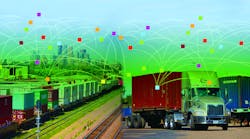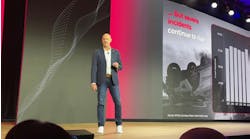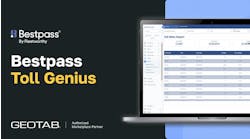Karol Smith was the first female dispatcher for BarOle Trucking. She started at the carrier some 20 years ago—before apps and mobile technology were a possibility. Now, as the trucking company’s safety manager, Smith has seen things change. A lot.
During her days as a dispatcher, Smith tells Fleet Owner drivers for the fleet, which has operations in Wisconsin and Minnesota and serves the Midwest, used to rely on pay phones, and dispatchers communicated container numbers in long, convoluted alphanumeric sequences that could easily be mistaken. Now, all the intermodal company’s employee drivers use cell phones that contain a dispatch app. Drivers take photos of container numbers with their phones and upload documents to the back office via the app.
“It’s eliminated a lot of errors in communication,” Smith says of the software. “As long as there’s no glitch in the photo, the process can be completed in 24 hours, whereas there used to be a two-week turnaround when documents were processed by hand.”
BarOle full-time drivers also use DriveWyze’s weigh station bypass app, and many of the owner-operators do, too. Smith says Google Maps is popular among the company’s drivers, as is the Minnesota 511 app, which has a trucking section that allows drivers to check truck routes, weather, road blockages, and construction.
BarOle drivers also use everyday social apps, like FaceTime, to video record problems on the road or with the truck in real time and send them to maintenance or the central office. According to Smith, that helps resolve problems faster and increases uptime.
“Overall the apps are good,” Smith explains. “They’ve eliminated a lot of communication errors and a lot of downtime as well. If the truck isn’t moving, the truck isn’t making money. So downtime is everything.”
But as a safety manager, Smith has her doubts and says she often wonders how much technology is too much, particularly when it comes to distractions on the road. Another problem, she adds, is when there’s a hiccup in the technology.
A mobile movement
In today’s world where mobile technology is constantly changing and apps for basically anything and everything abound, where do you start? For carriers and drivers, it depends on their day-to-day operations and needs. But one thing is certain: Apps that help reduce downtime and enable a return on investment have already and will continue to gain the highest traction throughout the industry.
Wallace Lau is a senior industry analyst for Frost & Sullivan’s automotive and transportation sector. He projects that the smartphone will be the primary device for truckers in the future—particularly for owner-operators. And everyone wants one app that can do it all.
“There are thousands of apps out there, and consumers don’t want to have to go back and forth to connect all these apps together,” Lau explains. “The best solution is an all-in-one app … I don’t think there’s one app out there yet that does everything.”
Christian Schenk, founder and president of One20 and TruckThat.com, takes that notion a step further. He says he believes a lot of apps today really aren’t much more than migrations from existing platforms that fleets and drivers are already required to use. TruckThat.com is a new social community for truckers to vent their frustrations about life on the road. A lot of the apps, he says, have no real perceived value and offer no reason for users to return.
“The one thing that remains constant for companies trying to build solutions for the independent truck driver is you can’t just be an app,” Schenk explains. “You have to provide value and an uptick in service—a feature that provides them with a solution they couldn’t do before.”
Schenk’s colleague Ryan Barnett, director of market development for One20, expands on Schenk’s theory and says apps need to do something “for a trucker rather than to a trucker.” What he means is that simply having an app is not enough. It must have the community and services around it to function properly.
“The industry will always gravitate to where community is,” he explains. “It comes down to the unique value of a social tool, like Facebook. Finding the right apps is really going to come down to where drivers hang out and what they do … The people experience hasn’t made it to truckers yet —even though there are a myriad of apps out there.”
When it comes to adopting those apps, Schenk says he believes the days of consumers paying for apps are long gone.
“I always challenge that if the industry really wants to do something for the driver—not to the driver— don’t make them pay for it,” he explains. “They are probably the most financially strapped professional. So many products and services require some kind of monetization that comes from the trucker, and that’s just never going to work.”
What fleets want
Cliff Dixon is the vice president of information at Tampa, FL-based Quality Distribution, which operates multiple subsidiaries under its brand—Quality Carriers, QC Energy Resources, and Boasso America. Dixon explains that the company’s fleet comprises different truck types and is a mix of independent contractors and affiliate trucks.
Quality first began using mobile technology in the early 2000s with a Qualcomm fleet-tracking app. Dixon says the company found that it was too costly and limiting and that it didn’t gather value from the product.
When BlackBerry emerged, the company began dabbling in what it could with smartphones. The problem was trusted networks weren’t broad enough to work in remote areas, Dixon explains. Over time, as eLogs and electronic logging devices came forward, Quality expanded its mobile efforts and partnered with a route tracker app as an eLog solution.
“What we found is that when we first started rolling out the BlackBerrys, drivers were saying, ‘This is too small,’” Dixon explains. “Then they started seeing the value of getting the next load in their truck.”
Quality converted to in-cab PeopleNet software devices in 2014, but drivers began pushing back. In their minds, the devices were a step back from using their phones, Dixon says. Then, PeopleNet released its ConnectedDriver app, which Quality drivers now use to receive updates, view back office messages, and keep track of hours of service.
“The biggest challenge we have now is we don’t see app sprawl for our drivers,” Dixon explains. “We want to give them access and the tools they need, but we don’t want them to have to go to multiple apps. But we’re not going to stop them from using their favorite weather or navigation app.”
“It’s a piece of the transportation industry that’s evolving,” he adds. “That mobile workforce has come to rely on their devices to connect and communicate, and the easier we make it for them, the more pleasurable the job is for them. It’s one more thing that could differentiate one company from another.”
Drivers’ perspectives
Though the mobile technology movement is upon us and here to stay, there are some who refuse to jump on board. Owner-operator Mike Beaulieu, who drives for BarOle, is one of them. He’s 66 and has been driving a truck since he was 14. Beaulieu calls mobile technology and apps dangerous distractions that hurt the industry.
“Everybody’s preaching safety to me,” he says. “Yet all the technology in these trucks is taking away from what you’re supposed to be doing—and that’s driving down the road.”
“I don’t think the dispatcher needs to know every hour of the day where I am,” Beaulieu adds. “I’m so glad I drive my own truck.”
Beaulieu drives a 1999 W900 Kenworth. He refuses to buy a newer model since his truck falls under the pre-2000 exemption rule of the ELD mandate, which goes into full effect December 2017.
Beaulieu doesn’t use BarOle’s dispatch app—or any app for that matter. Instead, he picks up loads and submits documents the old-school way. He does have a cellphone—a flip phone —and will use a Bluetooth device only because it provides hands-free communication.
Beaulieu is convinced apps and mobile devices have taken the one-on-one human interaction out of the business. And when it comes to tracking hours of service, he says new rules have made the roadways more dangerous.
“It has caused drivers to drive through that time because they are on a schedule and only have so far to go,” he explains. “Before, you could take a three-hour nap and it didn’t go against your work time; now, you can’t.”
“I never understood how white shirts and a bunch of suits who have never done our job can set the rules,” Beaulieu adds. “Electronics, as well-intended as they are meant to be, have basically hurt our industry as far as keeping everything safe and drivers on their game. Electronics cannot do my job.”
Unlike Beaulieu, Justin Jeske, 31, embraces apps and mobile technology. He’s also an owner-operator who drives for BarOle.
Jeske uses BarOle’s dispatch app to take and upload invoices and proof of deliveries. He says he likes not having to write anything down.
“This saves a lot of time because dispatchers put your whole day on there, and sometimes it’s hard to get people on the phone,” he explains. “Before the app, we could sit a half hour or 45 minutes waiting to get someone on the phone. Now, it could save up to an hour every day.”
Jeske says the only other app he really relies on is Google Maps.
“I don’t know how those guys back in the 70s, 80s, and 90s got around the big cities like Dallas and Chicago and Fort Worth without that,” he says. “It’s so nice, and it saves so much time.”
When he used to drive over the road, Jeske says he found the TruckerPath app helpful to locate truck stops. Though, he explains, he believes there is a need for an app that could do it all for truckers, particularly when it comes to finding safe overnight parking and rest stops.
Jeske isn’t looking forward to the upcoming ELD requirements, but he says he’d prefer an app on his phone over a clunky onboard system in his truck.
“I worked for a company for two months that ran those [ELDs], and I can tell you I’ve never been so tired in my life,” he says. “Once that clock starts, there’s no leeway—nothing … We’ve been getting along fine without electronic logs. I don’t see the need for it.”
BarOle is in the process of researching new telematics technology and monitoring driver behaviors, Smith explains, adding that the carrier is considering Rand McNally’s ELD app for drivers. But BarOle hasn’t made a decision yet. One problem the company could face down the road is getting owner-operators to install the technology in their trucks—or on their phones.
Overall, Smith says she believes the apps BarOle uses have eliminated potential communication errors and unnecessary downtime. She explains she is proud of how far the company has come in the last 20 years, but she urges fleets relying on mobile apps and technology to always have a backup plan when technical problems arise.
She, too, says there is a need for an app that can do it all, but the industry hasn’t developed one yet. Smith believes that if an app provider could figure out how to connect the thousands of trucking companies out there with their specific needs in one app, they’ll hit the jackpot.




